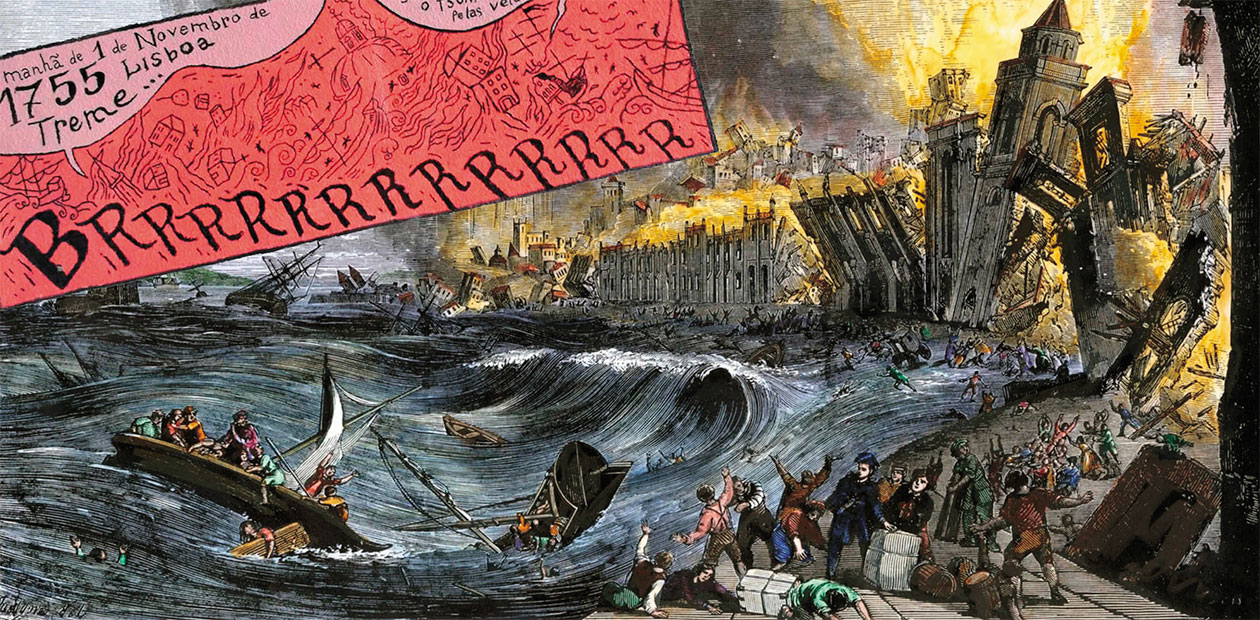The Shattering of Europe
The great Lisbon earthquake struck on the festive morning of November 1, 1755 – on All Saints’ Day. It not only destroyed the capital of Portugal, plunging the survivors into panic horror, but also shattered the minds of people throughout the enlightened Europe, raising the question about the “goodness of God” and the role of Providence in the world order and human affairs. This strongest earthquake in Europe, which caused the only transoceanic tsunami known in the Atlantic, impacted the development of seismology, one of the most important branches of modern geophysics
Imagine the warm and sunny morning of Saturday, November 1, 1755, All Saints’ Day, one of the main Catholic holidays. The blazing summer heat is gone; a mild morning breeze is blowing from the sea. All the churches in the capital city of Portugal are full of people who have come to the morning mass. In the palace, the royal family is getting ready to receive ambassadors, prelates, and ministers and to attend a solemn mass in the Cathedral of San Roque, richly decorated for the occasion. The streets in the city are teeming with people, festively dressed, heading to churches and market plazas, or just strolling along the promenade.
The harbor of Lisbon is full of ships from all over the world; the stores and warehouses of the adjoining Lower City abound with an immense variety of goods from all the four continents. Two months earlier, a flotilla of 28 ships returned from Rio de Janeiro, delivering to the metropolis almost 2.5 tons of Brazilian gold in sand and nuggets – worth more than 8 million reais! The ships also brought large cargoes of sugar, tropical spices, ivory, ebony, mahogany, whalebone… – all those goods for which the rest of Europe was willing to pay handsomely.
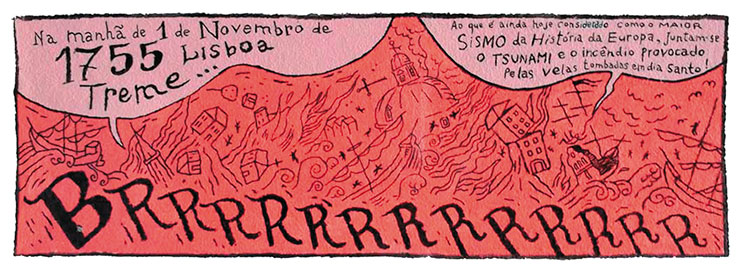
The end is approaching of the year 1755, one of the most successful years for the prosperous state. Situated on a narrow strip of the Iberian Peninsula, “regarded as a Cinderella” in Europe, as Stefan Zweig wrote about Portugal, with a population of barely more than one and a half million people, this country managed to use its geographical position to great advantage. Portugal began with mapping a sea route around Africa to deliver Indian jewelry and spices from the Moluccas to Europe, and by the mid‑16th century, it had become a great maritime power, the discoverer of the entire eastern hemisphere. Having turned its capital city into an entrance gate for goods from all over the world, Portugal became the main customs house of Europe and put on an equal footing in talks with such European giants as Italy, France, or Germany.
In the mid‑18th century, Lisbon became, in fact, not only the main seaport of Europe but also the fourth largest (after London, Paris, and Naples) European city with a population of about 275,000 people. This prosperous and genuinely beautiful city spread out over the hilly slopes on the right bank of the Tagus River. There was a popular saying among the Europeans: “Oui no ha visto Lisboa non ha visto cosa boa” (“He who has not seen Lisbon has not seen beauty”).
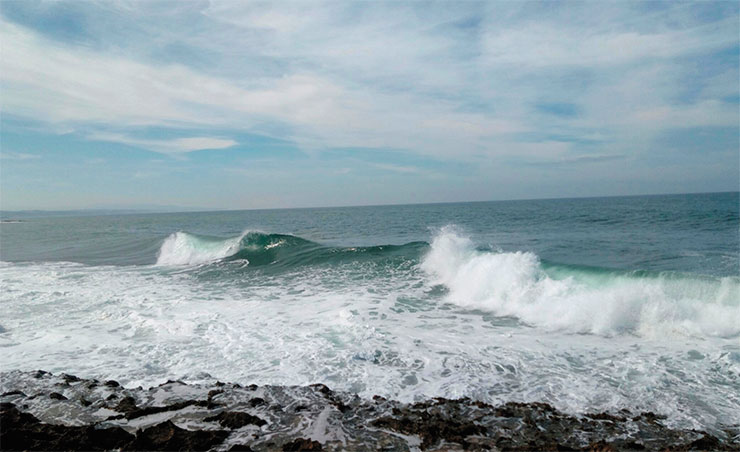
The favorable geographical position of Lisbon played an important role in the development of the city and all of Portugal. The city found it place at the Tagus’ mouth, a magnificent and well-protected harbor for ships. In this respect, Lisbon enjoyed undeniable advantages over Cadiz, the main Spanish port on the Atlantic, whose harbor was much less convenient because of its low, sloping shores, which offered little protection from Atlantic winter storms. Being the main waterway of the Iberian Peninsula, the Tagus gave Lisbon an excellent connection line with Toledo, a crucial economic and commercial center of Spain, which, in the 16–17th centuries, shared control with Portugal over the rest of the world.
But neither the riches nor the protected harbor proved able to save the majestic Portuguese capital from the natural disaster that struck the city on the festive autumn morning of November 1, 1755.
Rehearsal of the Apocalypse
Social upheavals such as epidemics, wars, or economic crises, and even natural disasters such as storms or floods are usually preceded by signs of an impending catastrophe, no matter how subtle and easy to miss. However, a strong earthquake always comes unheralded. Striking unexpectedly, it breaks the timeline for all those affected – people, cities, or entire states – into “before” and “after”. So it was in antiquity; so it is today, despite all the successes of seismology, despite targeted governmental programs for earthquake prediction, and despite thousands of sensors and instruments operating in seismically active areas.
However, it was a bit different with the Lisbon earthquake. After the disaster occurred, people would recall unusual natural phenomena, which were later regarded as formidable signs of the approaching natural cataclysm. Those signs included fluctuations in the level of water in wells, a change in the taste and color of well water, a change in the channels of small streams, the drying up of streams, the appearance of unpleasant sulphurous odors, anxiety in animals… However, all these events took place in different places and at different times; therefore, it was difficult to piece them all together into a single picture of an impending natural disaster.
In Lisbon, the earthquake began at about half past ten in the morning, local time. The ground trembled, and a dull, powerful rumble broke out, which sounded at times like thunder. The vibrations of the soil, which were small at first, just a trembling, were quickly increasing; objects began to fall down in the houses, and it became difficult for people to stay on their feet.
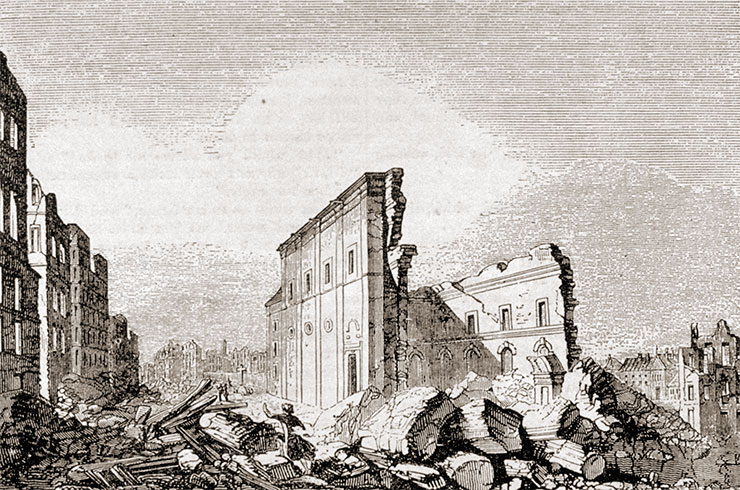
When the earthquake struck, few people could understand how long it would last and how strong it would be. There are no seismically active zones directly on the territory of Portugal and near its borders; strong earthquakes happen quite rarely here; according to historical data for the last thousand years, approximately every 52 years (Vikulin et al., 2007). However, over the past five years, the people of Lisbon had experienced six seismic shocks, which might well have been active manifestations of the upcoming strong earthquake.
People with faces paler than those of the dead, put hope in their legs alone; to save their lives, they would run up hill and down dale. Some of them jumped out of bed, covering their naked bodies with sheets, looking for a shelter and not finding any. Desperate, having lost hope of help, many saw no way to relieve their suffering other than to throw themselves into the abyss, opening their mouths to drink death.an eyewitness to the event (adapted from Tavares, 2005)
People on the streets felt as if the ground under their feet came to life; the paving stones began moving, and one could see earth waves on the surface. Those on the decks of ships in the bay of Lisbon saw the tall buildings of the city as if swaying from side to side “like ears of wheat from a light breeze in the fields,” as one of the captains would later recall. Cracks were emerging in the walls, with bricks and stones flying out. According to eyewitnesses, a strong rumble was heard clearly only during the first minute of the tremors; then it was obscured by other sounds of the catastrophe: the roar of falling objects and crumbling walls, the howling of horrified animals, the cries for help…
People who have lived their entire life on the plains, who grew up with an ingrained belief in the unshakability of the “earth firmament,” could hardly imagine the sensations of someone under whose feet this very “firmament” suddenly begins to shake. This feeling, the main ingredient of which is panic terror, can only be compared with the feeling of sudden weightlessness when an airplane hits a deep air hole, when every second seems like an eternity. People who live in seismically active areas and regularly experience ground tremors say that even a 30‑second earthquake seems endless. And the Lisbon earthquake lasted 7 minutes (!) with two short interrupts, which went unnoticed to many.
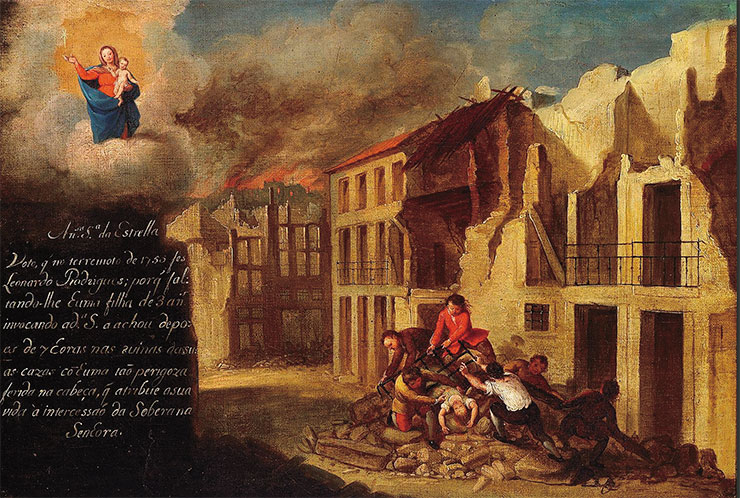
an eyewitness to the event (adapted from Tavares, 2005)
In the city, the force of the tremors reached 10 points on the modern 12‑point earthquake intensity scale. Apparently, the buildings began to collapse from the second minute on. People who were caught inside buildings were hit by ceilings, beams, rafters, and tile roofs; those who were out in the streets were struck by cornices, balconies, stucco molding, and then by wall fragments. A huge cloud of dust began to rise over the city, eclipsing the sun; it was so dense that people could hardly breathe.
Most of the people of Lisbon, who knew well the biblical traditions, thought that the quake manifested the end of the world predicted in the Apocalypse. Everyone sought to save themselves only, forgetting in those terrible moments about their significant others, about their children and parents, about “the most faithful wives.” As the Portuguese writer and historian Rui Tavares (2005) noted in his book dedicated to the Lisbon earthquake that exorbitant selfishness subsequently became the subject of an extensive debate, both in print and in public, as the sudden catastrophe exposed the human nature, showing the true price of claims to virtue and mercy.
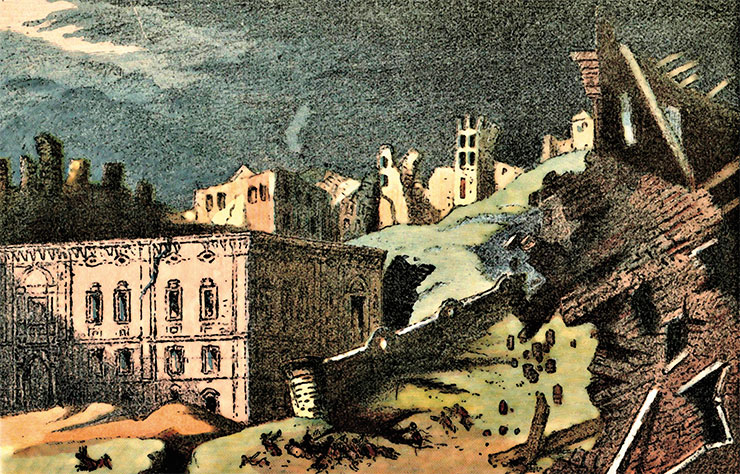
The absolute suddenness of the catastrophe, which ruled out any possibility of assessing the situation and preparing for it, forced people to act by instincts and subconscious reflexes, which are deeply embedded in human nature. As Tavares put it, this is where the ruthless truth of the earthquake lies – it exposes the nature of people who have lost their context and their culture.
By some quirk of fate, most of the buildings in Rua Formosa (Beautiful Street), which hosted the brothels of Lisbon, were almost undamaged, and so were their inhabitants. Against the backdrop of the thousands of parishioners who died in churches, this fact, which became widely known, greatly confused the supporters of piety and became a central pillar in the discussion that arose throughout the enlightened Europe about the “cruelty” or “goodness” of God.
When the seismic tremors were finally over, when the underground rumble and roar subsided and the dust began to settle, the survivors started regaining their senses, trying to understand what had happened. The appearance of the city had changed beyond recognition – entire blocks of buildings had disappeared; debris and rubble were covering the narrow streets. People would struggle their way towards the harbor, hoping to find refuge on the ships. Many others would run down towards the Tagus River, whose level dropped so low during the earthquake that in many places one could see its bottom. All the ships in the harbor had experienced a sea quake caused by the impact of seismic waves onto the bottom of the bay; the water in the harbor was boiling, and high waves were running, one after another, across the surface. And about an hour after the earthquake, a tsunami came from the ocean…
Ocean’s wrath
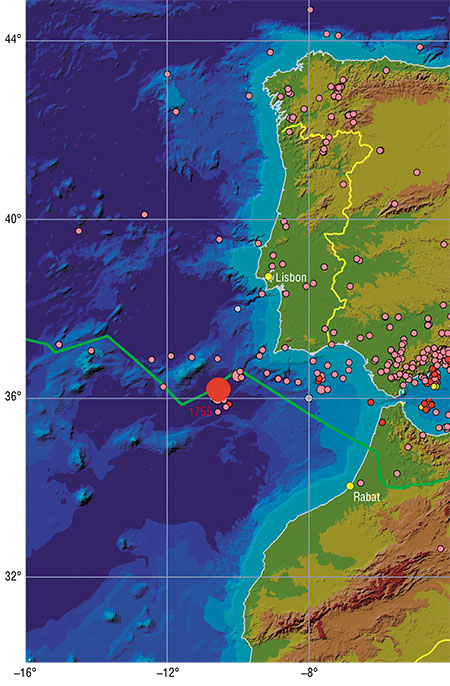 The source of the Lisbon earthquake was located in the Atlantic Ocean, on the boundary separating the Eurasian plate from the African one. As with all the earthquakes of the preinstrumental era, the exact location of its epicenter remains unknown; therefore, we can only make assumptions about its location from the map of isoseismal lines, which demarcate zones where the earthquake manifested itself with the same intensity. In the case of tsunamigenic earthquakes, the location of the source can be refined from the data on the travel times of the tsunami. However, the accuracy of such information in an era when clocks were regarded as a luxury leaves much to be desired.
The source of the Lisbon earthquake was located in the Atlantic Ocean, on the boundary separating the Eurasian plate from the African one. As with all the earthquakes of the preinstrumental era, the exact location of its epicenter remains unknown; therefore, we can only make assumptions about its location from the map of isoseismal lines, which demarcate zones where the earthquake manifested itself with the same intensity. In the case of tsunamigenic earthquakes, the location of the source can be refined from the data on the travel times of the tsunami. However, the accuracy of such information in an era when clocks were regarded as a luxury leaves much to be desired.
Currently, the source of the Lisbon earthquake is associated with a roughly 200‑km long segment of the interplate boundary, which runs along the ocean floor near a local rise formed by the elongated and rather shallow Gorringe Bank. While the average depth of the ocean floor near the interplate boundary is about 4.5 km, it does not exceed 400 m near the Gorringe Bank. Such a large difference in depth could have played a role in boosting the tsunami intensity through the contribution of underwater landslides and gravitational turbidity flows triggered by the earthquake. One can see traces of these landslides, which had descended from the underwater slopes of the Gorringe Bank, in the bottom drilling cores obtained in this area in 1970s‑1980s within the international Deep See Drilling Project.
According to the captain of a ship that happened to be near the Gorringe Bank at the time of the earthquake, the ship’s hull experienced severe blows; people on the deck were thrown up to a height of one and a half meters. The distance from the source of the earthquake to the harbor of Lisbon was about 250 km, and a tsunami wave can cover it in 50–60 min, which is consistent with the data on the time of arrival of the first wave to the harbor.
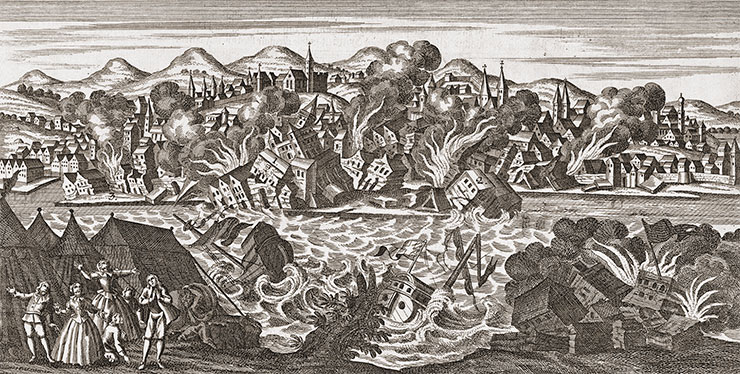
According to eyewitnesses, there were altogether three waves, of which the second one was the largest. Rising as high as 5–6 m, it tore off the harbored ships from their anchors and threw ashore hundreds of fishing boats. The Baixa (Lower City) streets, adjacent to the harbor, were flooded up to 250–300 m in-land; but since Lisbon lies on the slopes of hills smoothly descending towards the Tagus’ mouth, the tsunami’s contribution to the overall devastation of the city turned out to be relatively small.
The tsunami hit much harder the southwestern part of the Portuguese coast, where it was responsible for most of the damage. In the area of Cape San Vicente, the extreme southwestern tip of the Iberian Peninsula, waves rose as high as 15 m. Reports from coastal settlements in the Algarve province spoke of 30‑m waves; in this area, many coastal fortresses were destroyed or seriously damaged.
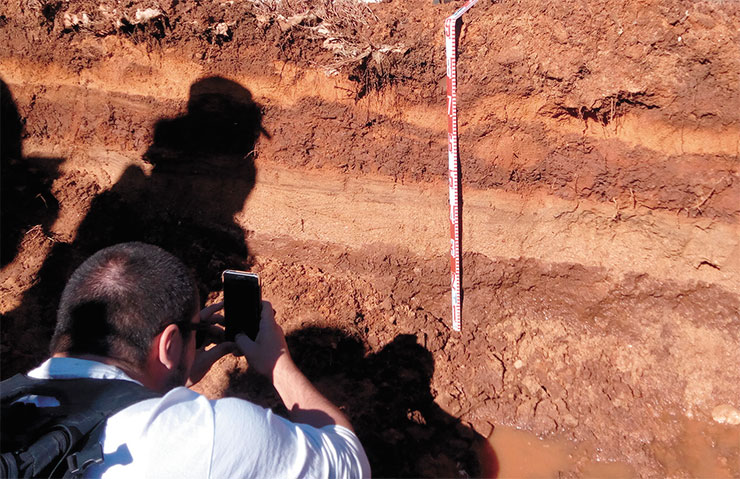
The tsunami’s impact was extremely destructive on the Spanish coast in the vicinity of Cadiz, where the wave heights reached 10–12 m. The African coast south of Gibraltar was also badly damaged. All harbors were destroyed in the Moroccan ports of Marrakesh, Casablanca, Tangier, Rabat, and Safi; the wave heights reached 15 m, and there were as many as thousands of casualties. The high tsunami waves swept over the Canaries and Azores.
It took seven hours for the tsunami to cross the Atlantic and reach the North American coast. We do not have any evidence about the height of the waves; presumably, they reached 1.5–2 m. The main blow hit the Caribbean. The tsunami swept through the entire chain of the Lesser Antilles, reaching a maximum height of 6.5 m on the island of Saba. No documentary evidence exists about tsunami victims in the Caribbean, but there definitely were victims since the tsunami arrived to the western coast of the Atlantic completely unheralded by any seismic precursors. The large wave came out of nowhere for the people of the Lesser Antilles, and everyone who was on the shore had little chance of survival.
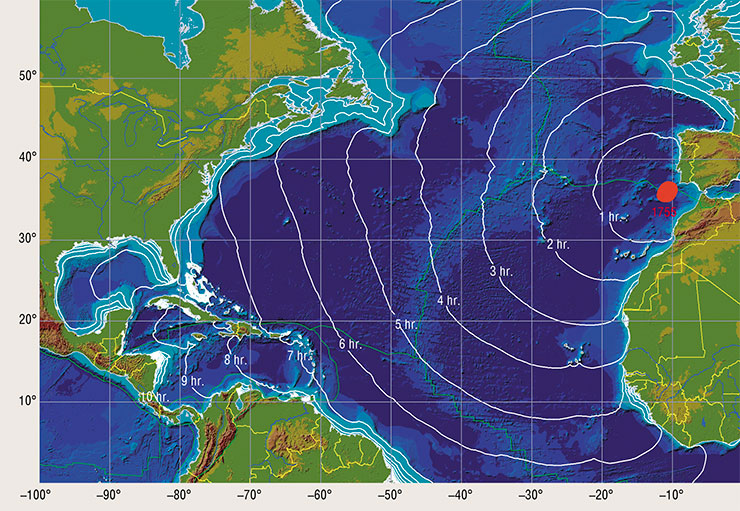
Thus, the ancient Japanese believed that earthquakes were due to movements of a catfish, the one the Japanese islands rested upon, in their worldview. The Europeans were content with the explanation given by Aristotle, who attributed the cause of earthquakes to winds (the movement of air, one of the four primary elements) looking for a way out of the caves in the bowels of the Earth, where they had previously penetrated from the atmosphere.
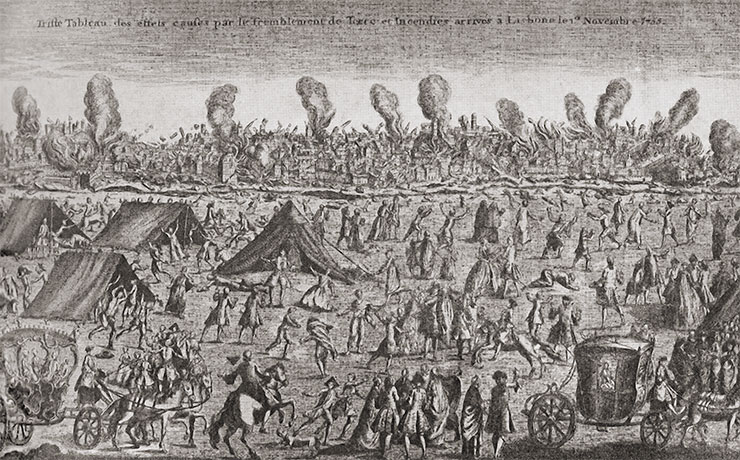
The Lisbon disaster forced European scientists to search for physical mechanisms underlying this natural phenomenon. As early as 1760, the English naturalist and geologist John Mitchell published his book Conjectures Concerning the Cause and Observations upon the Phenomena of Earthquakes. Based on the contemporary achievements of mechanics, he came to the correct conclusion that the vibrations of the soil during an earthquake are due to the passage of elastic waves caused by the movement of rocks miles below the Earth’s surface.
The earthquake and the related events had such a profound influence on the young Immanuel Kant that this German philosopher put a lot of effort to collect all the available information. His reflections resulted in developing his own theory about the causes of earthquakes, which he associated with the collapse of underground cavities filled with combustible gases
The seismic energy released at the source is estimated from the earthquake magnitude. The latter is measured in arbitrary units (from 1 to 9.5 on the Richter scale), which are calculated from the vibrations recorded by the seismograph. The earthquake of 1755 was undoubtedly the strongest one in the history of the entire European continent – the majority of European historical catalogs assign it a magnitude of 8.5–8.7. And the magnitude scale creator himself, the American seismologist Charles Richter (1958), who analyzed the macroseismic effect and the pattern of resonant fluctuations (seiches) of the water level in European lakes, estimated its magnitude at 8.7–9.0.
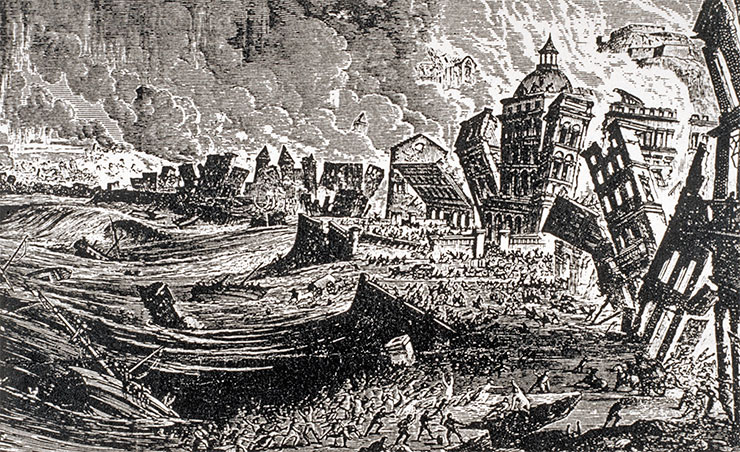
Considering the location of the source, the destructive manifestations of the tsunami in the nearest parts of the coast, and the height of the waves on the opposite coasts of the Atlantic, we can rightfully speak of a magnitude of 9.0, i. e., classify the 1755 event as a mega-earthquake capable of generating transoceanic tsunamis (Gusiakov, 2016).
Earth, water, and fire
The retreat of the third wave from the coast was not yet the end of the catastrophe that befell Lisbon. Towards evening, the main danger for the survivors was coming from the fires that broke out under the debris – during earthquakes, fires always occur in areas with dense urban conditions. One such example is the gigantic fire that engulfed Tokyo after the earthquake of September 1, 1923. Owing to the large amount of wood and paper typical of a traditional Japanese home, the fire quickly turned into a firestorm, which is where most of the 140,000 victims of the Tokyo earthquake actually died.
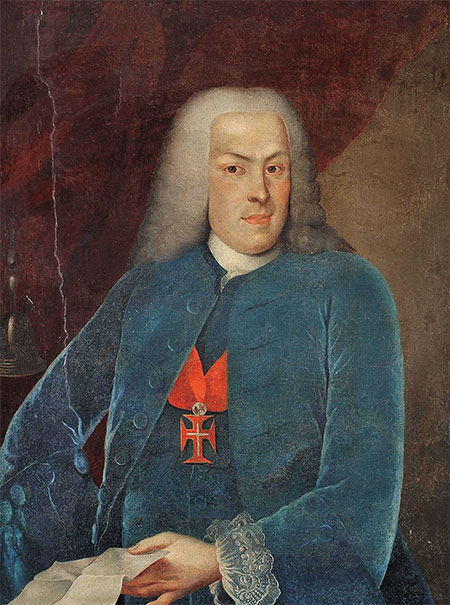
The palaces, churches, and residential homes of Lisbon were mostly built of stone, but they had wooden floors, ceilings, doors, and furniture, which provided enough food for the fire that arose from overturned candles, church chandeliers, and unextinguished domestic hearths. Many people died in fire and smoke, unable to get out through the debris. The most terrible fate awaited the wounded and crippled people caught by the fire inside the buildings. Thus, four hundred patients were burnt in the All Saints Hospital; the same fate befell many prisoners in the jailhouse of the Inquisition, which was half destroyed by the earthquake. The fire burnt down to ground the Royal Palace, the Patriarchal Cathedral, and the building of the Lisbon Opera House (Ópera do Tejo), which was opened only seven months before the earthquake.
The fire destroyed the countless artistic and cultural treasures amassed in Lisbon over the previous two centuries. The royal library alone kept more than 70,000 books, including priceless early books printed before 1500, and unique geographical maps. The royal archives kept ship logs, journals, and descriptions of the voyages accomplished by the great navigators, starting with Bartolomeo Diaz and Vasco da Gama.
All these treasures were irretrievably lost. The fires kept on burning until late in the night; people had nothing to put them out with, and no one was actually capable of such effort. People who had escaped from the completely destroyed parts of the city to the surrounding hills could see the glow from the fire that consummated the destruction of the capital. Anecdotal evidence suggests that combustible gases, rising to the surface along the opened cracks and faults, contributed to the broad spread and the long (up to three days) duration of the fires.
Comprehending the scale and significance of the Lisbon natural disaster, the Marquis of Pombal realized that everything ought to be recorded accurately for posterity. He himself compiled a special questionnaire about the event and its consequences and ordered to send it to all the provinces of the country. It included questions such as: How long did the earthquake last? How many strong shocks were there? What is the degree of destruction of buildings? How did the animals behave? What happened to the water sources? The answers to these questions, still kept in the National Archives of Portugal, made it possible to accurately assess the magnitude of the earthquake. It was not until the second half of the 20th century that the distribution of such questionnaires after every major earthquake became a standard practiceThe royal family was not injured during the earthquake, but the shock was such that King Don Jose I decided against restoring the ruined palace. The next few years the royal family spent in a field camp on the eastern outskirts of the city, at the foot of the Ajuda hill, where the now famous Royal Tents were erected.
This behavior, motivated by the fear of buildings with thick stone walls, offering good protection from the summer heat yet so dangerous in an earthquake, was typical of many Lisbon survivors for many years after the disaster. Having lost their homes, most of the city people were forced to move to nearby villages, where they first took shelter in linen tents and then began to build wooden houses. The fear of a new earthquake was largely fueled by repeated shocks occurring many times a day. Such socks, called aftershocks, always accompany the release of residual stresses in the source area. And this process continued for many long months.
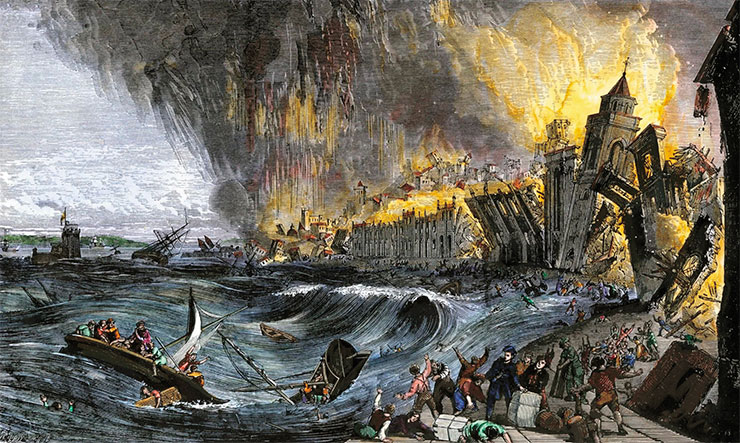
The total number of victims of the Lisbon disaster still remains the subject of debate, primarily due to the lack of accurate data on the city’s population – cited numbers vary from 10,000 to 90,000 people. No one ever made any accurate calculations, so now it is not possible to estimate which part of the residents died under the ruins and which part from the fire.
We can only say with certainty that the number of deaths from the tsunami could not exceed 10 % of the total number of victims; therefore, an estimate of 1,000 people seems very realistic (Baptista et al., 1998). This number was obtained from the ratio between the city areas affected by the seismic shocks and by the tsunami. In general, Lisbon is located at a considerable elevation with respect to the sea level in the harbor, so even 6‑m waves could have flooded only a strip of land adjacent to the port no more than 2–3 km long and 200–350 m wide, which is a small portion of the total city area.
“Bury the dead and feed the living”
No matter how great the death toll from the Lisbon earthquake, most of the city population survived. But the survivors lost almost all their livelihoods, which necessitated urgent decisive measures to provide for at least the very basic needs.
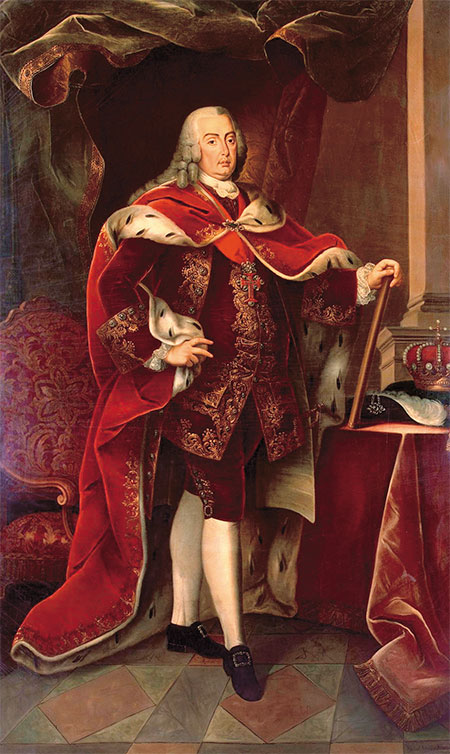
Fortunately, there was a man in the government who took up the responsibility for restoring the normal life of people in the capital city and on the adjoining territories. This man was the royal minister Sebastião José de Carvalho e Melo (Count of Oeiras), who went down in history as the Marquis of Pombal. His common sense and indomitable energy contributed in no small measure to the quick launching of “rescue operations,” as we call them today. When the king asked him what should be done in the case of an all-devastating disaster, the minister gave his well-known answer: “Bury the dead and feed the living.”
As early as in December 1755, Sebastião José was appointed to the post of Secretary for the Kingdom (which today would be equal to the post of Minister of the Interior), and he actually took over the leadership on the affected areas. King Don Jose I found in him a man with a strong will, a clear understanding of the immediate goals and objectives, and a readiness for the most decisive action in order to achieve the goals.
The primary goal so as to prevent a plague epidemic was to bury the bodies of dead people and animals. To this end, army units were summoned into the city from the neighboring provinces. Another issue was to coordinate with Catholic prelates a hastened procedure for the funeral rituals set by the church. An equally urgent task was to quickly restore the food supply to the city, for which measures were taken to ensure the urgent delivery of grain and other products from the neighboring provinces. Trade took place in the Rossio Square, where the city exchange was located, and the tradesmen were ordered, under the threat of severe reprisals, to sell food supplies at the prices that were effective before the earthquake.
Another important task was to combat crime. The third tsunami wave, which flooded the port quarters of the city, had barely retreated when Lisbon was seized by a wave of looting, robbery, and violence. The scale of crime was so huge that the most severe measures had to be taken to stop it. A royal decree ordered that marauders and robbers that were caught red-handed be executed on the same day without trial or investigation. Gallows were set up in all the districts of the city, and they were immediately put to work. When hanged criminals were taken off the gallows, their heads were cut off and piled into pyramids on the platforms. Only measures so severe proved able to stop the robberies and rampant violence in the devastated city.
Less urgent, but no less important, was the task of clearing the streets and restoring the transport network in the affected districts. To this end, a royal decree ordered that cannons be used to demolish all the damaged buildings, regardless of their ownership (royal, public, or private), and the debris be removed from the city.
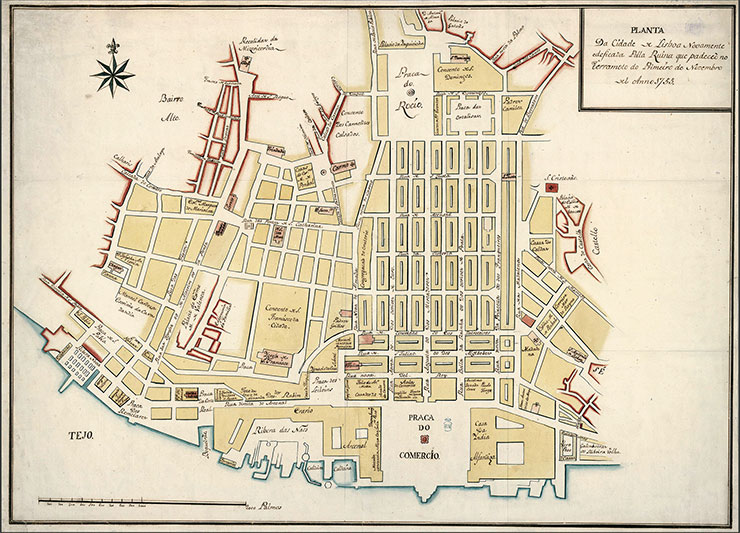
As normal life was being restored, the state faced in all the magnitude the problem of restoring the capital city. As early as December 5, 1755, a project proposal for the restoration of Lisbon was submitted to the king. The project was drafted by a military engineer General Manuel da Maia. He proposed five options for restoring the city, which differed in their degree of radicalness. The first four of them were based on a fairly reasonable (even from the viewpoint of modern seismology) approach to assessing the frequency of strong earthquakes. The general pointed out that the earthquake that took place was not a harbinger of a new one, and since in all the previous years, such phenomena did not occur in Lisbon, one should not expect them to repeat in the foreseeable future.
The first option was to restore the city in the same form as before November 1, 1755, while retaining the property rights to the land plots. This option would have inevitably led to restoring the chaotic urban development pattern in Baixa, the urban quarters adjacent to the harbor. The second option allowed for the modernization of the main streets, specifically, their expansion and straightening, under the condition of minimizing the compensations to the former owners of the plots. The third option proposed to completely ignore the property rights of the former owners and proceed only from the city’s interests; this plan also called for a ban on buildings taller than three stories.
The fourth option was the most radical one. According to this project, the city planning had to be fully revised; the streets had to be made geometrically correct, and private houses, as well as destroyed public buildings and temples, had to be relocated according to the new plan. Eventually, it was the fourth option that was approved and implemented. As for the fifth option proposed by General da Maia, i. e., to build a new capital on unoccupied lands between Alcântara and Belém, neither the government nor the people Lisbon supported it.
The shattering of minds
The news about the Lisbon earthquake spread quickly throughout Europe for the pre-telegraph times, primarily through newspapers and private letters, books and brochures, drawings and engravings.
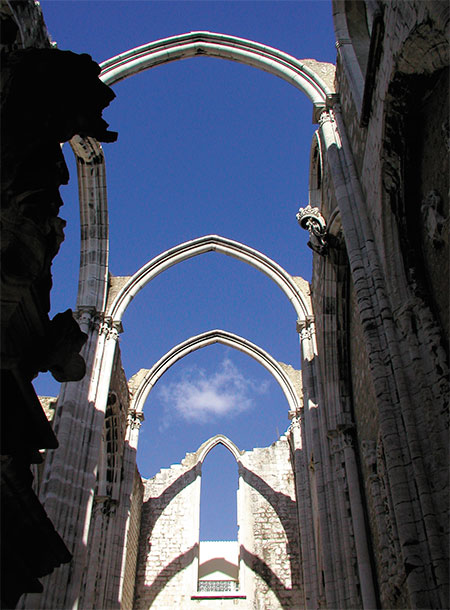
Even in distant Russia, the first newspaper article appeared as early as December 5, 1755. The newspaper Sankt-Peterburgskie Vedomosti wrote: “A communication was received with a courier who arrived from Madrid that on the 1st of November, there was a terrible shaking of the earth along the Spanish coast and throughout the Portuguese kingdom, because of which earthworks and stone structures in various cities dropped down; more than half of the Portuguese capital of Lisbon fell apart, having crushed to death about 100,000 people within a few minutes.”
Notably, this article already gives an estimate for the number of deaths in the earthquake, i. e., “100,000 people,” which now seems heavily overestimated, but such a figure only reflects the impression that the Lisbon disaster made on the contemporaries. In pursuit of sensations, some newspapers even wrote that the city “ceased to exist on geographical maps.”
The public attention to this event was largely fueled by the fact that seismic tremors were sensed over a vast area, i. e., almost the entire western half of the European continent, and the ensuing water fluctuations in lakes and bays were observed even in Scandinavia. Thinking minds throughout Europe immediately realized that the disaster that befell Portugal was a matter for deep contemplation on the nature of existence, on what in this world belongs to God and what belongs to society, i. e., to religion, science, and politics.
Clerical circles predominantly shared the idea of “Divine Wrath,” which implied that the catastrophe was due to the sins committed by the people of Lisbon, to their insufficient love of God and zeal in faith. But representatives of the intellectual elite of the “enlightened” 18th century could not agree with that.
In December 1755, the French philosopher and writer Voltaire published his Poem on the Lisbon Disaster, in which he objected to those who believed the earthquake to be God’s punishment: “Did fallen Lisbon deeper drink of vice than London, Paris, or sunlit Madrid? In these men dance; at Lisbon yawns the abyss.”
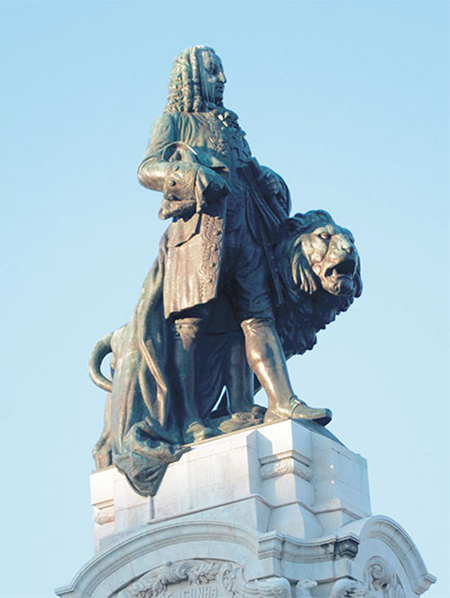
However, the German philosopher and scientist G. W. Leibniz, the advocate of “the common good,” admitted that disasters and catastrophes could occur in this “best of all possible worlds,” created by God in the most perfect way. People could suffer from them badly, but this suffering was much less than that caused by people themselves, he argued, recalling that Caligula and Nero did more evil than the famous fires of 64 AD, which destroyed half of Rome.
Polemicizing with Leibniz, Voltaire wrote his satire Candide: Optimism (1758), a grotesque comedy unfolding against the backdrop of the Lisbon disaster and turning into an outright farce, which ridiculed Leibniz’s main postulate that “everything is good in this best of all worlds.”
The thinking people of Europe kept on contemplating the causes of the catastrophe and could not but come to the conclusion that both extreme points of view on the disaster that befell Lisbon were not fully valid. Yes, earthquakes happen all the time in seismically active areas, but it is not the earthquake itself that kills people but the roofs and walls of large buildings made of heavy stones, which they foolishly build in such areas. Here, in this thinking, we can see the embryos of those ideas that would lead in the 20th century to the introduction of legal regulations for seismic zoning and earthquake-resistant construction.
However, even nowadays, the scientific problems associated with a realistic assessment of seismic hazard cannot be considered definitively resolved. The Probabilistic Seismic Hazard Assessment (PSHA) method, adopted in many countries, is subject to fair criticism (Kossobokov and Nekrasova, 2012; Mulargia et al., 2017; and others). Moreover, there is an unresolved issue of earthquake-resistant construction in seismically active areas, i. e., determining the necessary margin of safety for buildings in view of destruction risks during seismic shocks, and in tsunami-prone areas.
Even if a consensus is achieved between seismologists, civil engineers, and decision-makers on the construction of complex and expensive objects or mass housing development, the actual implementation of such projects is often far from what was intended. Thus, the earthquake in Haiti on January 12, 2010, which claimed about 210,000 lives, revealed an issue with the implementation of adopted regulations in the field of earthquake-resistant construction. It turned out that, according to global statistics, the death rate from devastating earthquakes in different countries is closely correlated with the level of corruption considered “acceptable” in the construction industry (Ambrasyes and Bilham, 2011).
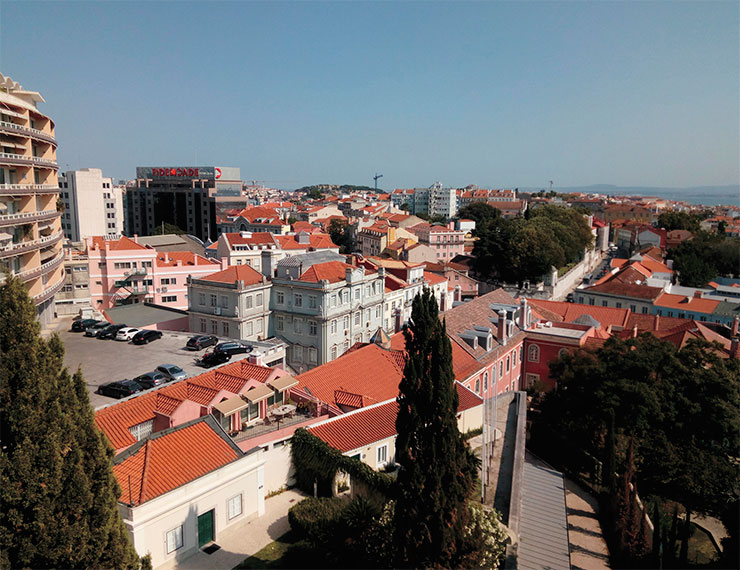
The Great Lisbon earthquake, which occurred on November 1, 1755, still remains the strongest one throughout the European history and one of the ten strongest earthquakes in the world’s history. It not only destroyed one of the richest capitals in Europe but also manifested itself on a territory as vast as almost a half of the continent, as such was the area where tremors were sensed. All this, coupled with the sufficiently developed means of communication (newspapers, brochures, books, private mail), stirred up the cultural space of the Old World.
Today, when two and a half centuries have passed since that what might seem as a purely geological event, we cannot but see that it occurred at a crucial turning point in the European history and culture. It anticipated the end of the centuries-old era of absolute monarchies (less than forty years was left to the Great French Revolution), raised serious ethical and ideological questions, and partly shook the faith of the great enlighteners of the mid‑18th century in the power of the scientific method. In the minds of “mere mortals,” this natural disaster gave rise to doubts about the unchanging divine protection for all those who are true believers and live their lives in accordance with religious precepts.
References
Ambrasyes, N. and Bilham, R. Corruption kills // Nature. 2011. V. 469. P. 153–155.
Baptista, M. A., Heitor, S., Miranda, J. M. et al. The 1755 Lisbon tsunami; evaluation of the tsunami parameters // J. Geodynamics. 1998. V. 25. N. 2. P. 143–157.
Gusiakov, V. K. Strongest tsunamis in the World Ocean and the problem of marine coastal security // Izv. RAN. Fizika atmosphery i okeana. 2014. V. 90. N 5. P. 496–507 [in Russian].
Kossobokov, V. G. and Nekrasova, A. K. Global Seismic Hazard Assessment Program Maps are Erroneous // Seismic Instruments. 2012. V. 48. N. 2. P. 162–170.
Kozak, J. T., Moreira, V. S., and Oldroyd, D. R. Iconography of the 1755 Lisbon Earthquake. Praha: Geophysical Institute, Academy of Sciences of the Czech Republic, 2005. 84 p.
Nikonov, A. A. The “horrible shattering” of Europe: the Lisbon earthquake of November 1, 1755 // Priroda. 2005. N 11. P. 21–29 [in Russian].
Santos, A., Correia, V., Loureiro, C., and Fernandes, P. Marques da Costa N. The historical reconstruction of the 1755 earthquake тand tsunami in downtown Lisbon, Portugal // J. Mar. Sci. Eng. 2019. V. 7. P. 208.
Tavares, R. O. Pequeno Livro do Grande Terramoto: Ensaio sobre 1755. Tinta da China, 2005 (A Short Book on the Great Earthquake, Trans. by Matos, R. Tinta-da-China, 2020).
Vikulin, A. V., Vikulina, S. A., and Argas, L. New data on the Lisbon earthquake of November 1, 1755 // Vestn. KRAUNTs. Nauki o Zemle. 2007. N 2, Issue 10. P. 74–86 [in Russian].


